2014 MERCEDES-BENZ GL weight
[x] Cancel search: weightPage 13 of 462

Folding in/out (automatically).......123
Folding in/out (electrically)...........123
Folding in when locking (on-board
computer)......................................286
Out of position (troubleshooting)...123
Setting...........................................123
Storing settings (memory function) 125
Storing the parking position..........124
Eyeglasses compartment.................342
F
Filler cap
see Fuel filler flap
Flat tire
MOExtended tires..........................387
Preparing the vehicle.....................387
TIREFIT kit ...................................... 388
see Emergency spare wheel
Floormats...........................................367
Folding the rear bench seat
forwards/back..................................344
Fording
Off-road.........................................195
On flooded roads...........................195
Front windshield
see Windshield
Fuel
Additives........................................447
Consumption statistics..................275
Displaying the current
consumption..................................276
Displaying the range......................276
Driving tips....................................192
Fuel gauge.......................................33
Grade (gasoline)............................446
Important safety notes..................446
Low outside temperatures.............448
Premium-grade unleaded gasoline.446
Problem (malfunction)...................185
Quality (diesel)...............................447
Refueling ........................................ 182
Tank content/reserve fuel.............446
Fuel filler flap
Opening.........................................184
Fuel filter (display message)............309
Fuel level
Calling up the range (on-board
computer)......................................276
Fuel tank
Capacity........................................446
Problem (malfunction)...................185
Fuses
Allocation chart.............................400
Before changing.............................400
Dashboard fuse box.......................401
Fuse box in the engine
compartment.................................401
Fuse box under rear bench seat....402
Important safety notes..................400
G
Garage door opener
Clearing the memory.....................367
General notes................................364
Important safety notes..................364
Opening/closing the garage door..367
Programming (button in the rear-
view mirror)...................................364
Gear indicator (on-board computer)287
Genuine parts......................................23
Glove box...........................................341
GTW (Gross Trailer Weight)
(definition).........................................425
H
Handbrake
see Parking brake
Hazard warning lamps......................132
Headlamps
Fogging up.....................................135
see Automatic headlamp mode
Head restraints
Adjusting.......................................108
Adjusting (electrically)...................109
Adjusting (manually)......................109
Adjusting (rear)..............................110
Installing/removing (rear)..............110
Luxury ............................................ 109
Heating
see Climate control
Index11
Page 22 of 462
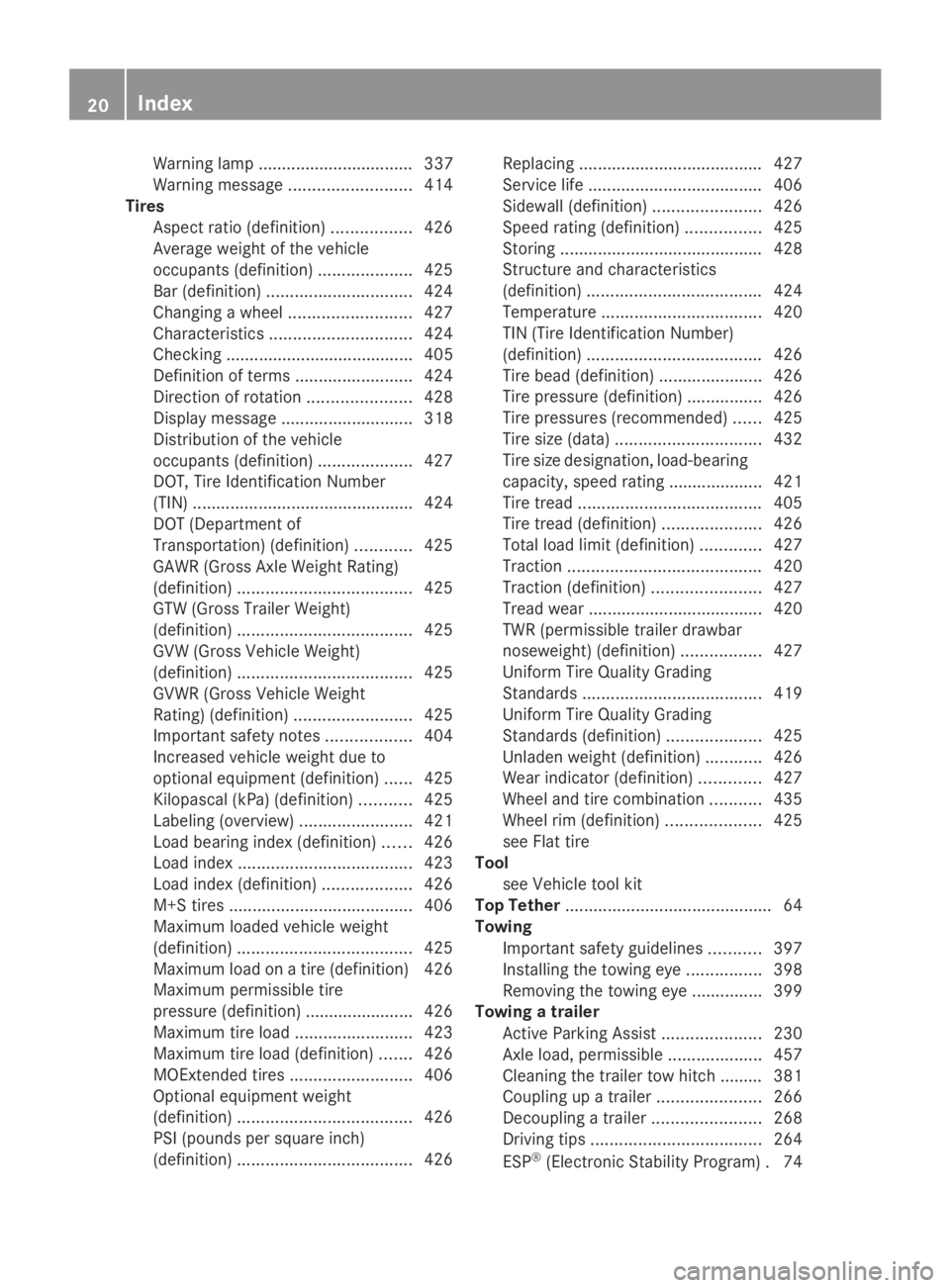
Warning lamp ................................. 337
Warning message..........................414
Tires
Aspect ratio (definition).................426
Average weight of the vehicle
occupants (definition)....................425
Bar (definition)...............................424
Changing a wheel..........................427
Characteristics..............................424
Checking ........................................ 405
Definition of terms.........................424
Direction of rotation......................428
Display message............................318
Distribution of the vehicle
occupants (definition)....................427
DOT, Tire Identification Number
(TIN) ...............................................424
DOT (Department of
Transportation) (definition)............425
GAWR (Gross Axle Weight Rating)
(definition).....................................425
GTW (Gross Trailer Weight)
(definition).....................................425
GVW (Gross Vehicle Weight)
(definition).....................................425
GVWR (Gross Vehicle Weight
Rating) (definition).........................425
Important safety notes..................404
Increased vehicle weight due to
optional equipment (definition)......425
Kilopascal (kPa) (definition)...........425
Labeling (overview)........................421
Load bearing index (definition)......426
Load index.....................................423
Load index (definition)...................426
M+S tires.......................................406
Maximum loaded vehicle weight
(definition).....................................425
Maximum load on a tire (definition) 426
Maximum permissible tire
pressure (definition) ....................... 426
Maximum tire load.........................423
Maximum tire load (definition).......426
MOExtended tires..........................406
Optional equipment weight
(definition).....................................426
PSI (pounds per square inch)
(definition).....................................426
Replacing.......................................427
Service life.....................................406
Sidewall (definition).......................426
Speed rating (definition)................425
Storing...........................................428
Structure and characteristics
(definition).....................................424
Temperature..................................420
TIN (Tire Identification Number)
(definition).....................................426
Tire bead (definition)......................426
Tire pressure (definition)................426
Tire pressures (recommended)......425
Tire size (data)...............................432
Tire size designation, load-bearing
capacity, speed rating .................... 421
Tire tread.......................................405
Tire tread (definition).....................426
Total load limit (definition).............427
Traction.........................................420
Traction (definition).......................427
Tread wear.....................................420
TWR (permissible trailer drawbar
noseweight) (definition).................427
Uniform Tire Quality Grading
Standards......................................419
Uniform Tire Quality Grading
Standards (definition)....................425
Unladen weight (definition)............426
Wear indicator (definition).............427
Wheel and tire combination...........435
Wheel rim (definition)....................425
see Flat tire
Tool
see Vehicle tool kit
Top Tether............................................64
Towing
Important safety guidelines...........397
Installing the towing eye................398
Removing the towing eye...............399
Towing a trailer
Active Parking Assist.....................230
Axle load, permissible....................457
Cleaning the trailer tow hitch ......... 381
Coupling up a trailer......................266
Decoupling a trailer.......................268
Driving tips....................................264
ESP®(Electronic Stability Program).74
20Index
Page 23 of 462
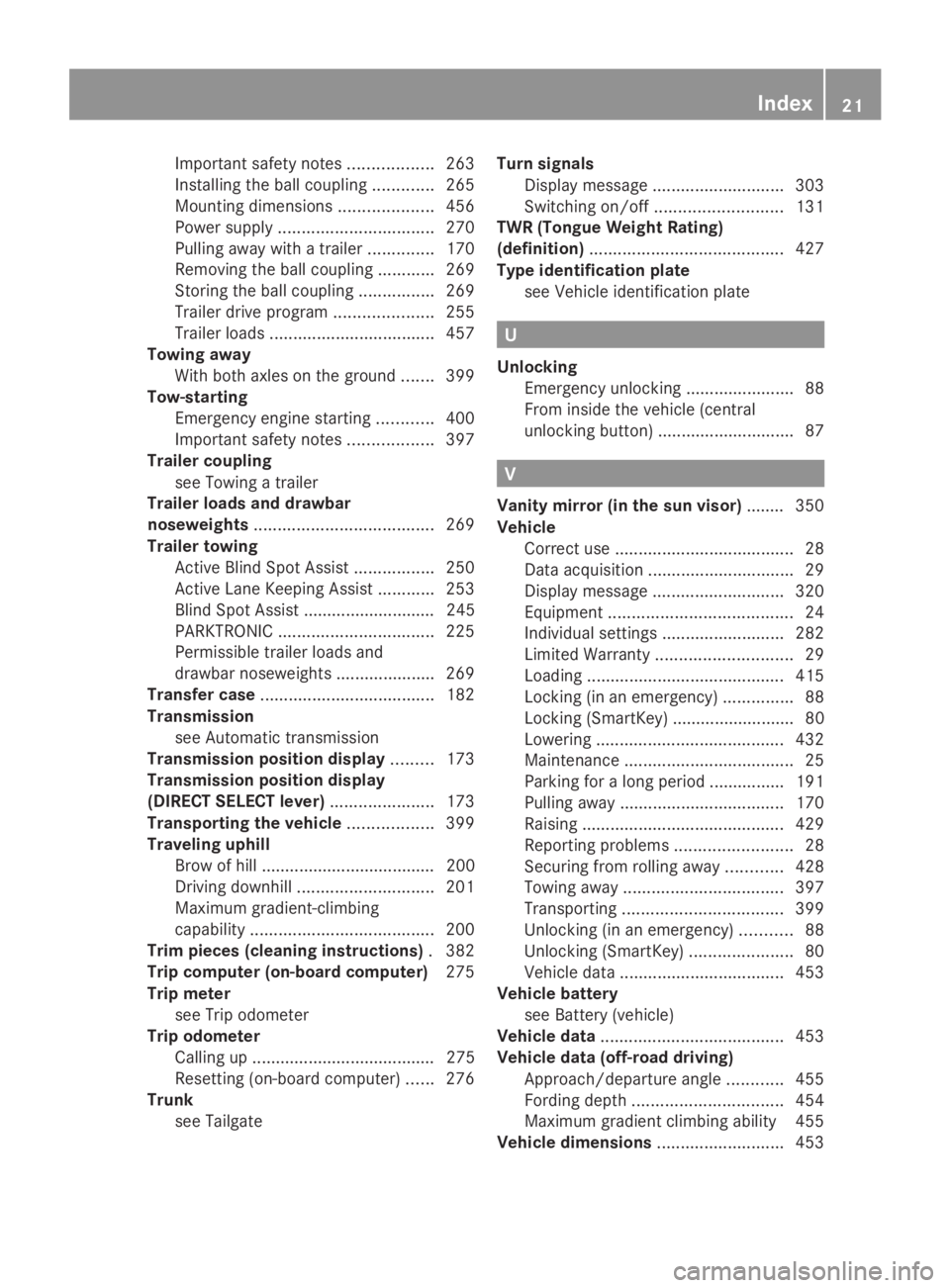
Important safety notes..................263
Installing the ball coupling.............265
Mounting dimensions....................456
Power supply.................................270
Pulling away with a trailer..............170
Removing the ball coupling............269
Storing the ball coupling................269
Trailer drive program.....................255
Trailer loads...................................457
Towing away
With both axles on the ground.......399
Tow-starting
Emergency engine starting............400
Important safety notes..................397
Trailer coupling
see Towing a trailer
Trailer loads and drawbar
noseweights......................................269
Trailer towing
Active Blind Spot Assist.................250
Active Lane Keeping Assist............253
Blind Spot Assist ............................ 245
PARKTRONIC.................................225
Permissible trailer loads and
drawbar noseweights.....................269
Transfer case.....................................182
Transmission
see Automatic transmission
Transmission position display.........173
Transmission position display
(DIRECT SELECT lever)......................173
Transporting the vehicle..................399
Traveling uphill
Brow of hill ..................................... 200
Driving downhill.............................201
Maximum gradient-climbing
capability.......................................200
Trim pieces (cleaning instructions).382
Trip computer (on-board computer)275
Trip meter
see Trip odometer
Trip odometer
Calling up ....................................... 275
Resetting (on-board computer)......276
Trunk
see Tailgate
Turn signals
Display message............................303
Switching on/off...........................131
TWR (Tongue Weight Rating)
(definition).........................................427
Type identification plate
see Vehicle identification plate
U
Unlocking
Emergency unlocking.......................88
From inside the vehicle (central
unlocking button).............................87
V
Vanity mirror (in the sun visor)........350
Vehicle
Correct use......................................28
Data acquisition...............................29
Display message............................320
Equipment.......................................24
Individual settings..........................282
Limited Warranty.............................29
Loading..........................................415
Locking (in an emergency)...............88
Locking (SmartKey) .......................... 80
Lowering........................................432
Maintenance....................................25
Parking for a long period ................ 191
Pulling away...................................170
Raising...........................................429
Reporting problems.........................28
Securing from rolling away............428
Towing away..................................397
Transporting..................................399
Unlocking (in an emergency)...........88
Unlocking (SmartKey)......................80
Vehicle data...................................453
Vehicle battery
see Battery (vehicle)
Vehicle data.......................................453
Vehicle data (off-road driving)
Approach/departure angle............455
Fording depth................................454
Maximum gradient climbing ability 455
Vehicle dimensions...........................453
Index21
Page 25 of 462
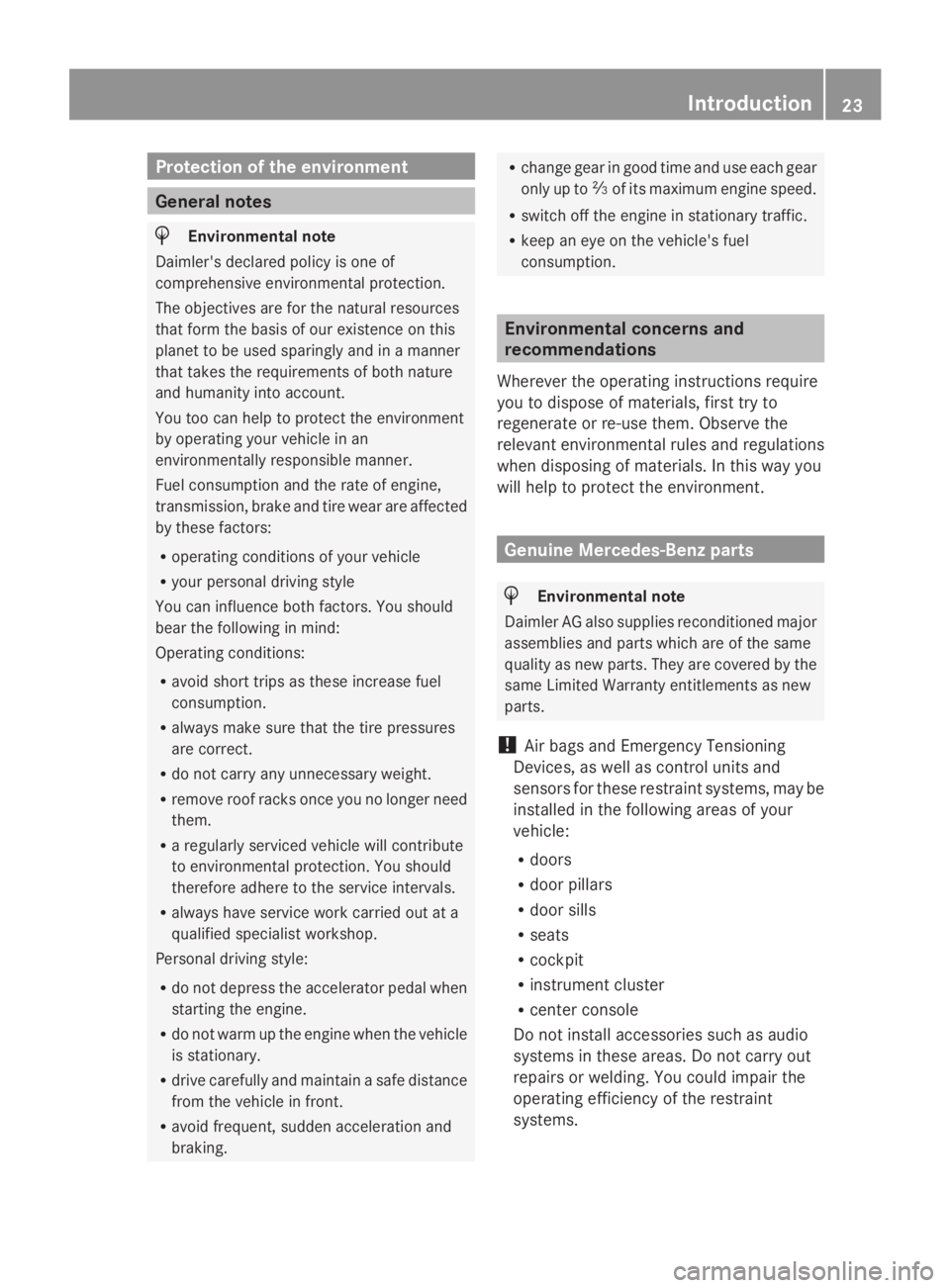
Protection of the environment
General notes
HEnvironmental note
Daimler's declared policy is one of
comprehensive environmental protection.
The objectives are for the natural resources
that form the basis of our existence on this
planet to be used sparingly and in a manner
that takes the requirements of both nature
and humanity into account.
You too can help to protect the environment
by operating your vehicle in an
environmentally responsible manner.
Fuel consumption and the rate of engine,
transmission, brake and tire wear are affected
by these factors:
Roperating conditions of your vehicle
Ryour personal driving style
You can influence both factors. You should
bear the following in mind:
Operating conditions:
Ravoid short trips as these increase fuel
consumption.
Ralways make sure that the tire pressures
are correct.
Rdo not carry any unnecessary weight.
Rremove roof racks once you no longer need
them.
Ra regularly serviced vehicle will contribute
to environmental protection. You should
therefore adhere to the service intervals.
Ralways have service work carried out at a
qualified specialist workshop.
Personal driving style:
Rdo not depress the accelerator pedal when
starting the engine.
Rdo not warm up the engine when the vehicle
is stationary.
Rdrive carefully and maintain a safe distance
from the vehicle in front.
Ravoid frequent, sudden acceleration and
braking.
Rchange gear in good time and use each gear
only up to�
Page 47 of 462
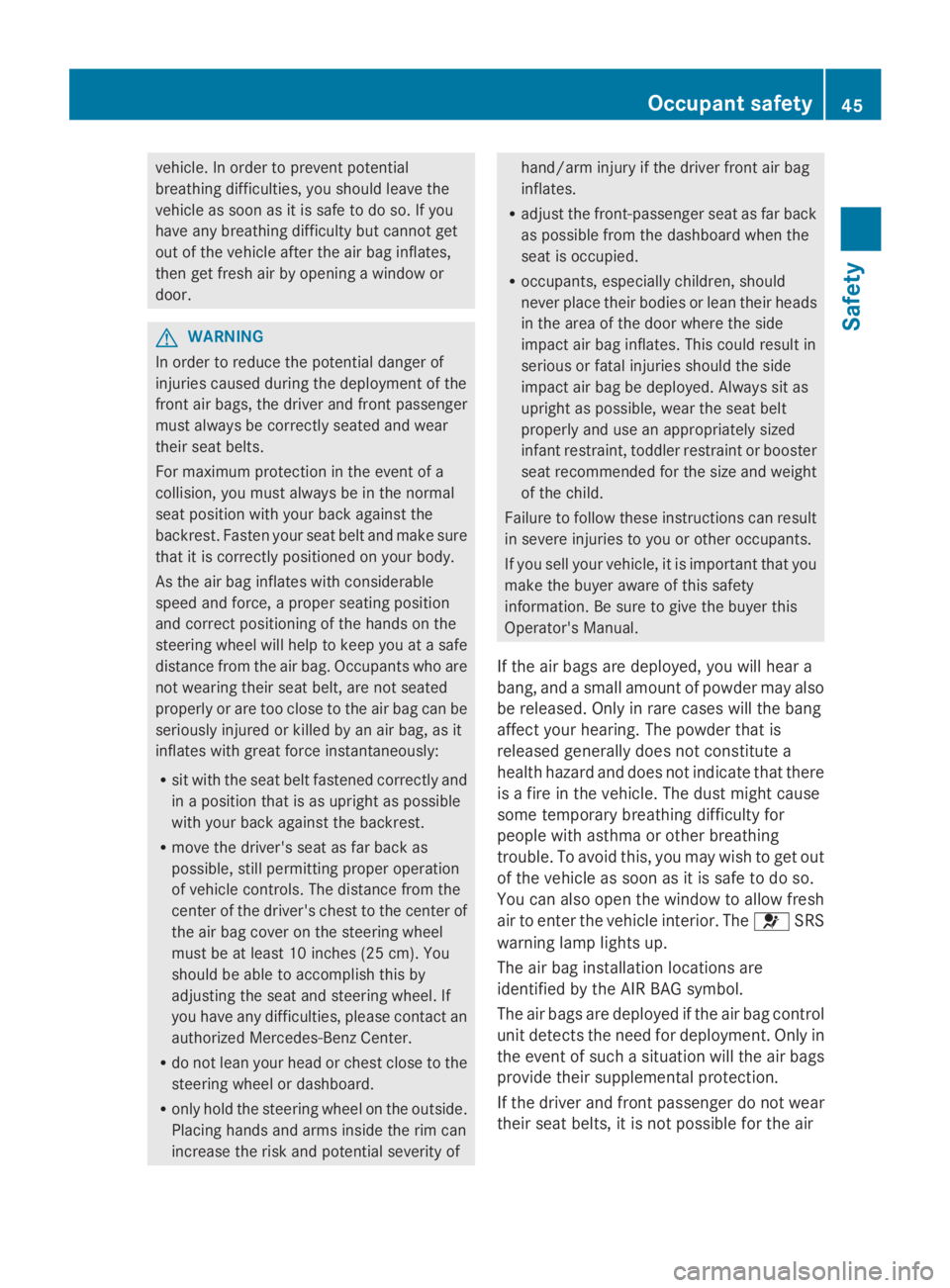
vehicle. In order to prevent potential
breathing difficulties, you should leave the
vehicle as soon as it is safe to do so. If you
have any breathing difficulty but cannot get
out of the vehicle after the air bag inflates,
then get fresh air by opening a window or
door.
GWARNING
In order to reduce the potential danger of
injuries caused during the deployment of the
front air bags, the driver and front passenger
must always be correctly seated and wear
their seat belts.
For maximum protection in the event of a
collision, you must always be in the normal
seat position with your back against the
backrest. Fasten your seat belt and make sure
that it is correctly positioned on your body.
As the air bag inflates with considerable
speed and force, a proper seating position
and correct positioning of the hands on the
steering wheel will help to keep you at a safe
distance from the air bag. Occupants who are
not wearing their seat belt, are not seated
properly or are too close to the air bag can be
seriously injured or killed by an air bag, as it
inflates with great force instantaneously:
Rsit with the seat belt fastened correctly and
in a position that is as upright as possible
with your back against the backrest.
Rmove the driver's seat as far back as
possible, still permitting proper operation
of vehicle controls. The distance from the
center of the driver's chest to the center of
the air bag cover on the steering wheel
must be at least 10 inches (25 cm). You
should be able to accomplish this by
adjusting the seat and steering wheel. If
you have any difficulties, please contact an
authorized Mercedes-Benz Center.
Rdo not lean your head or chest close to the
steering wheel or dashboard.
Ronly hold the steering wheel on the outside.
Placing hands and arms inside the rim can
increase the risk and potential severity of
hand/arm injury if the driver front air bag
inflates.
Radjust the front-passenger seat as far back
as possible from the dashboard when the
seat is occupied.
Roccupants, especially children, should
never place their bodies or lean their heads
in the area of the door where the side
impact air bag inflates. This could result in
serious or fatal injuries should the side
impact air bag be deployed. Always sit as
upright as possible, wear the seat belt
properly and use an appropriately sized
infant restraint, toddler restraint or booster
seat recommended for the size and weight
of the child.
Failure to follow these instructions can result
in severe injuries to you or other occupants.
If you sell your vehicle, it is important that you
make the buyer aware of this safety
information. Be sure to give the buyer this
Operator's Manual.
If the air bags are deployed, you will hear a
bang, and a small amount of powder may also
be released. Only in rare cases will the bang
affect your hearing. The powder that is
released generally does not constitute a
health hazard and does not indicate that there
is a fire in the vehicle. The dust might cause
some temporary breathing difficulty for
people with asthma or other breathing
trouble. To avoid this, you may wish to get out
of the vehicle as soon as it is safe to do so.
You can also open the window to allow fresh
air to enter the vehicle interior. The�uSRS
warning lamp lights up.
The air bag installation locations are
identified by the AIR BAG symbol.
The air bags are deployed if the air bag control
unit detects the need for deployment. Only in
the event of such a situation will the air bags
provide their supplemental protection.
If the driver and front passenger do not wear
their seat belts, it is not possible for the air
Occupant safety45
Safety
Z
Page 48 of 462
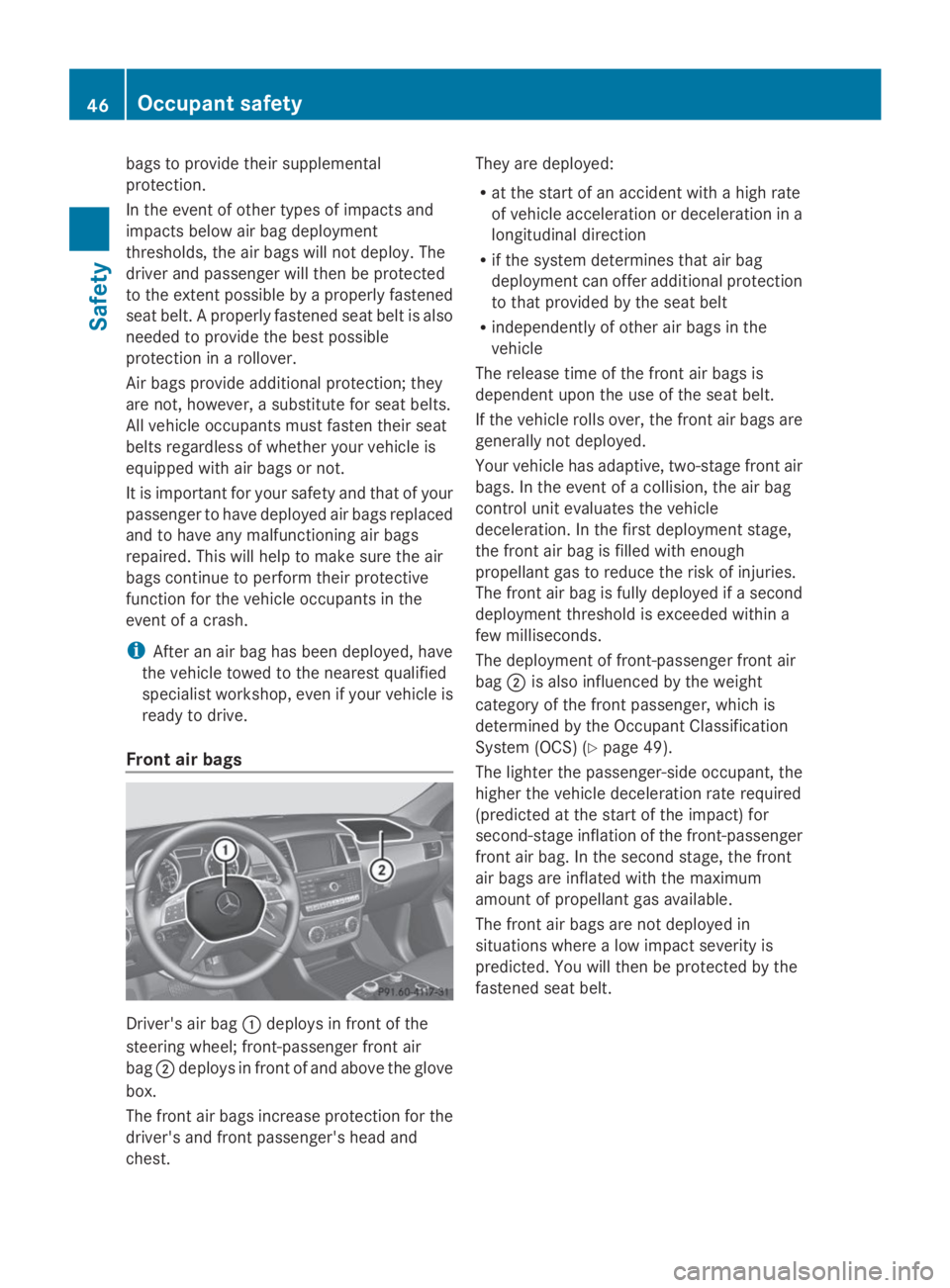
bags to provide their supplemental
protection.
In the event of other types of impacts and
impacts below air bag deployment
thresholds, the air bags will not deploy. The
driver and passenger will then be protected
to the extent possible by a properly fastened
seat belt. A properly fastened seat belt is also
needed to provide the best possible
protection in a rollover.
Air bags provide additional protection; they
are not, however, a substitute for seat belts.
All vehicle occupants must fasten their seat
belts regardless of whether your vehicle is
equipped with air bags or not.
It is important for your safety and that of your
passenger to have deployed air bags replaced
and to have any malfunctioning air bags
repaired. This will help to make sure the air
bags continue to perform their protective
function for the vehicle occupants in the
event of a crash.
iAfter an air bag has been deployed, have
the vehicle towed to the nearest qualified
specialist workshop, even if your vehicle is
ready to drive.
Front air bags
Driver's air bag�Cdeploys in front of the
steering wheel; front-passenger front air
bag�Ddeploys in front of and above the glove
box.
The front air bags increase protection for the
driver's and front passenger's head and
chest.
They are deployed:
Rat the start of an accident with a high rate
of vehicle acceleration or deceleration in a
longitudinal direction
Rif the system determines that air bag
deployment can offer additional protection
to that provided by the seat belt
Rindependently of other air bags in the
vehicle
The release time of the front air bags is
dependent upon the use of the seat belt.
If the vehicle rolls over, the front air bags are
generally not deployed.
Your vehicle has adaptive, two-stage front air
bags. In the event of a collision, the air bag
control unit evaluates the vehicle
deceleration. In the first deployment stage,
the front air bag is filled with enough
propellant gas to reduce the risk of injuries.
The front air bag is fully deployed if a second
deployment threshold is exceeded within a
few milliseconds.
The deployment of front-passenger front air
bag�Dis also influenced by the weight
category of the front passenger, which is
determined by the Occupant Classification
System (OCS) (Ypage 49).
The lighter the passenger-side occupant, the
higher the vehicle deceleration rate required
(predicted at the start of the impact) for
second-stage inflation of the front-passenger
front air bag. In the second stage, the front
air bags are inflated with the maximum
amount of propellant gas available.
The front air bags are not deployed in
situations where a low impact severity is
predicted. You will then be protected by the
fastened seat belt.
46Occupant safety
Safety
Page 49 of 462
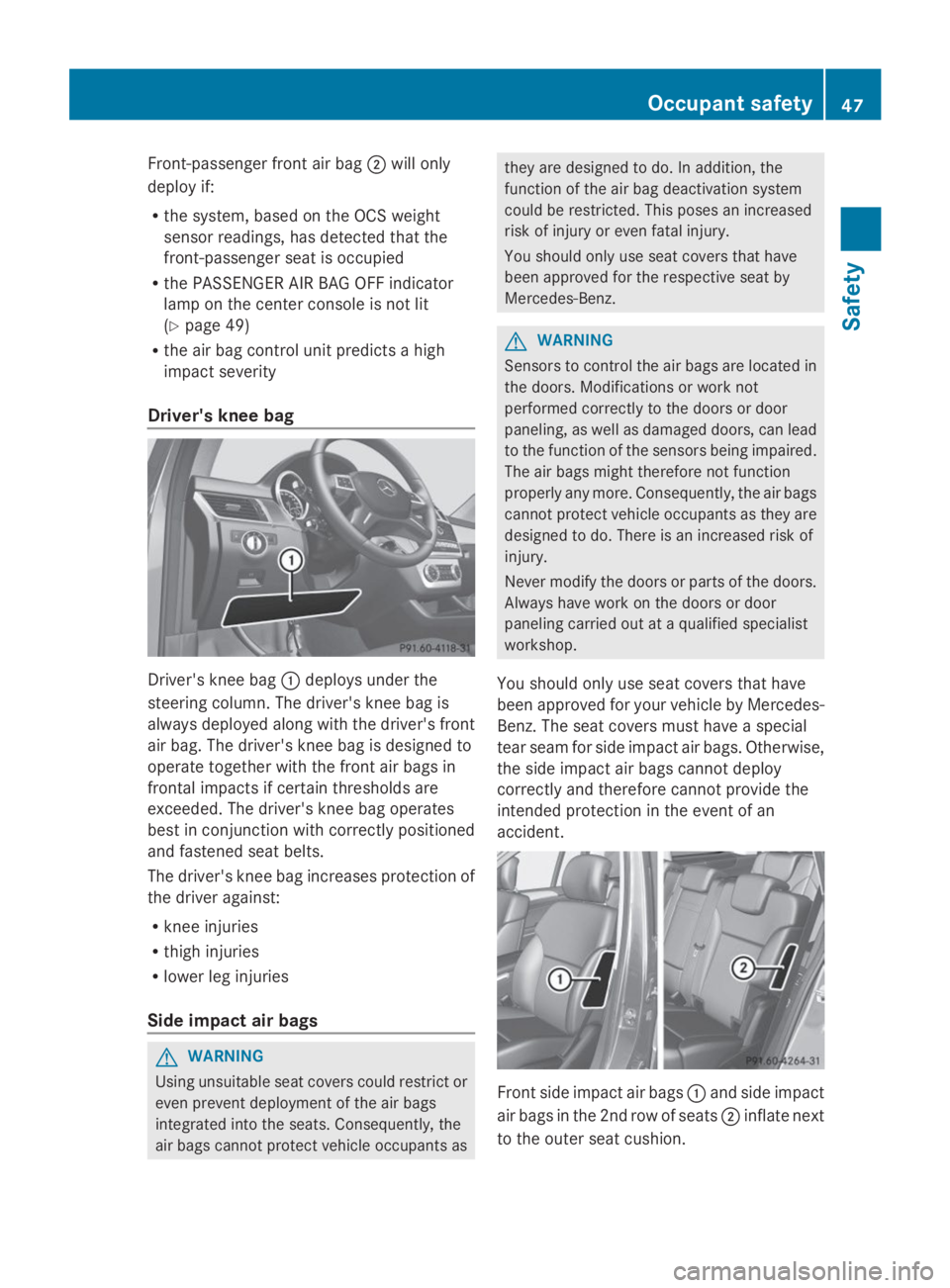
Front-passenger front air bag�Dwill only
deploy if:
Rthe system, based on the OCS weight
sensor readings, has detected that the
front-passenger seat is occupied
Rthe PASSENGER AIR BAG OFF indicator
lamp on the center console is not lit
(Ypage 49)
Rthe air bag control unit predicts a high
impact severity
Driver's knee bag
Driver's knee bag�Cdeploys under the
steering column. The driver's knee bag is
always deployed along with the driver's front
air bag. The driver's knee bag is designed to
operate together with the front air bags in
frontal impacts if certain thresholds are
exceeded. The driver's knee bag operates
best in conjunction with correctly positioned
and fastened seat belts.
The driver's knee bag increases protection of
the driver against:
Rknee injuries
Rthigh injuries
Rlower leg injuries
Side impact air bags
GWARNING
Using unsuitable seat covers could restrict or
even prevent deployment of the air bags
integrated into the seats. Consequently, the
air bags cannot protect vehicle occupants as
they are designed to do. In addition, the
function of the air bag deactivation system
could be restricted. This poses an increased
risk of injury or even fatal injury.
You should only use seat covers that have
been approved for the respective seat by
Mercedes-Benz.
GWARNING
Sensors to control the air bags are located in
the doors. Modifications or work not
performed correctly to the doors or door
paneling, as well as damaged doors, can lead
to the function of the sensors being impaired.
The air bags might therefore not function
properly any more. Consequently, the air bags
cannot protect vehicle occupants as they are
designed to do. There is an increased risk of
injury.
Never modify the doors or parts of the doors.
Always have work on the doors or door
paneling carried out at a qualified specialist
workshop.
You should only use seat covers that have
been approved for your vehicle by Mercedes-
Benz. The seat covers must have a special
tear seam for side impact air bags. Otherwise,
the side impact air bags cannot deploy
correctly and therefore cannot provide the
intended protection in the event of an
accident.
Front side impact air bags�Cand side impact
air bags in the 2nd row of seats�Dinflate next
to the outer seat cushion.
Occupant safety47
Safety
Z
Page 51 of 462
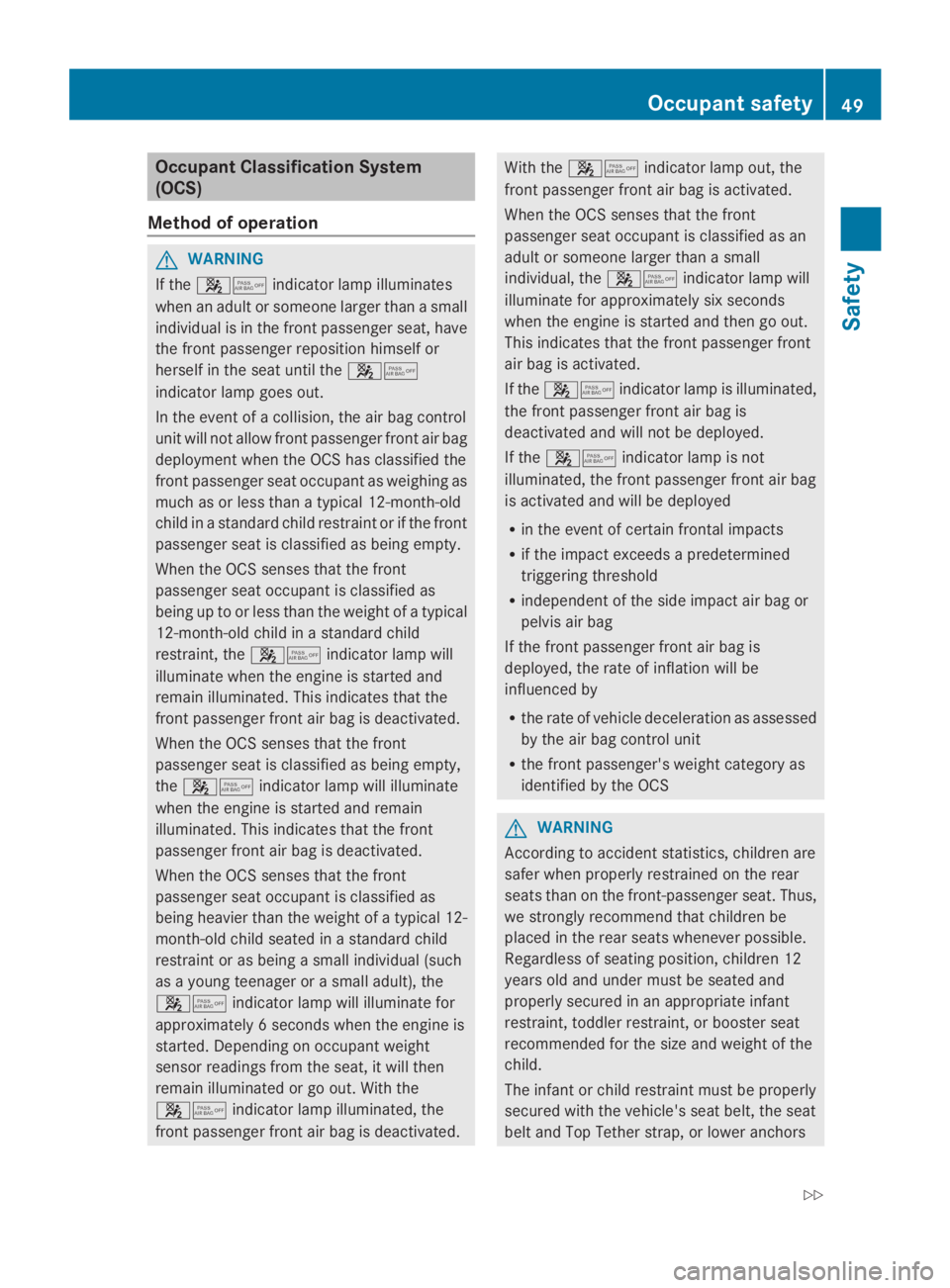
Occupant Classification System
(OCS)
Method of operation
GWARNING
If the�s�tindicator lamp illuminates
when an adult or someone larger than a small
individual is in the front passenger seat, have
the front passenger reposition himself or
herself in the seat until the�s�t
indicator lamp goes out.
In the event of a collision, the air bag control
unit will not allow front passenger front air bag
deployment when the OCS has classified the
front passenger seat occupant as weighing as
much as or less than a typical 12-month-old
child in a standard child restraint or if the front
passenger seat is classified as being empty.
When the OCS senses that the front
passenger seat occupant is classified as
being up to or less than the weight of a typical
12-month-old child in a standard child
restraint, the�s�tindicator lamp will
illuminate when the engine is started and
remain illuminated. This indicates that the
front passenger front air bag is deactivated.
When the OCS senses that the front
passenger seat is classified as being empty,
the�s�tindicator lamp will illuminate
when the engine is started and remain
illuminated. This indicates that the front
passenger front air bag is deactivated.
When the OCS senses that the front
passenger seat occupant is classified as
being heavier than the weight of a typical 12-
month-old child seated in a standard child
restraint or as being a small individual (such
as a young teenager or a small adult), the
�s�tindicator lamp will illuminate for
approximately 6 seconds when the engine is
started. Depending on occupant weight
sensor readings from the seat, it will then
remain illuminated or go out. With the
�s�tindicator lamp illuminated, the
front passenger front air bag is deactivated.
With the�s�tindicator lamp out, the
front passenger front air bag is activated.
When the OCS senses that the front
passenger seat occupant is classified as an
adult or someone larger than a small
individual, the�s�tindicator lamp will
illuminate for approximately six seconds
when the engine is started and then go out.
This indicates that the front passenger front
air bag is activated.
If the�s�tindicator lamp is illuminated,
the front passenger front air bag is
deactivated and will not be deployed.
If the�s�tindicator lamp is not
illuminated, the front passenger front air bag
is activated and will be deployed
Rin the event of certain frontal impacts
Rif the impact exceeds a predetermined
triggering threshold
Rindependent of the side impact air bag or
pelvis air bag
If the front passenger front air bag is
deployed, the rate of inflation will be
influenced by
Rthe rate of vehicle deceleration as assessed
by the air bag control unit
Rthe front passenger's weight category as
identified by the OCS
GWARNING
According to accident statistics, children are
safer when properly restrained on the rear
seats than on the front-passenger seat. Thus,
we strongly recommend that children be
placed in the rear seats whenever possible.
Regardless of seating position, children 12
years old and under must be seated and
properly secured in an appropriate infant
restraint, toddler restraint, or booster seat
recommended for the size and weight of the
child.
The infant or child restraint must be properly
secured with the vehicle's seat belt, the seat
belt and Top Tether strap, or lower anchors
Occupant safety49
Safety
Z